November Data - January Reporting
MICHIGAN UNEMPLOYMENT RATE INCREASES IN NOVEMBER

On a seasonally adjusted basis, Michigan’s unemployment rate rose by two-tenths of a percentage point to 4.3 percent during November.
Since October 2023, the national jobless rate inched down by two-tenths of a percentage point to 3.7 percent. Michigan’s unemployment rate was 0.6 percentage points above the U.S. rate. At 4.3 percent, Michigan’s jobless rate matched that of Arizona, Kentucky, and New York as the sixth-highest rate in the nation in November. Across the U.S., unemployment rates ranged from 1.8 percent in Maryland to 5.4 percent in Nevada.
Over the year, the U.S. unemployment rate advanced by one-tenth of a percentage point, while the statewide unemployment rate was reduced by one-tenth of a percentage point. Since November 2022, Michigan’s unemployment rate decrease of one-tenth of a percentage point was tied with Louisiana, Maine, and Nevada as the 23rd largest drop in the nation.
Over the month, Michigan’s workforce rose by 0.5 percent, an increase comparable to the labor force increase seen nationally (+0.3 percent). Statewide employment levels edged up by 0.3 percent, while the U.S. employment total rose by 0.5 percent since October. In November, total unemployment in Michigan rose by 4.3 percent, while total unemployment in the U.S. receded by 3.3 percent.

Source: Local Area Unemployment Statistics, Michigan Center for Data and Analytics, Michigan Department of Technology, Management & Budget
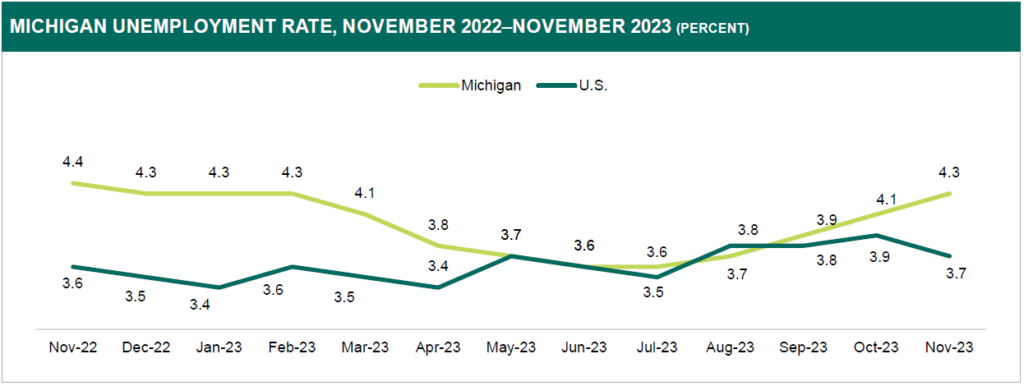
Source: Local Area Unemployment Statistics, Michigan Center for Data and Analytics, Michigan Department of Technology, Management & Budget
Since November 2022, Michigan’s labor force advanced by 4.2 percent, which was tied with South Carolina as the highest in the nation. The national labor force observed a 2.3 percent gain over the same period. Over the year, statewide employment levels increased by 4.3 percent, while U.S. employment levels rose by 2.2 percent. Total unemployment in Michigan increased by 2.9 percent over the year, 2.0 percentage points below the total unemployment advance of 4.9 percent in the U.S.
REIMA NASSER
Economic Analyst
STATEWIDE NONFARM PAYROLL JOBS ADVANCE MARGINALLY IN NOVEMBER
Total nonfarm payroll jobs in Michigan increased marginally by 7,100 or 0.2 percent over the month, rising to 4,423,200 in November, on a seasonally adjusted basis. Payroll jobs on the statewide level have now advanced in three of the past six months and nine times within the past year. As of November 2023, total employment in Michigan continued to remain below its February 2020 pre-pandemic level (-26,300 or 0.6 percent). Despite the minimal November job change, Michigan was ranked the 10th highest among all 50 U.S. states in terms of monthly nonfarm job level change.
Seasonally adjusted nonfarm payroll jobs on the nationwide level moved up minimally in November, increasing by only 0.1 percent. Beginning in December 2020, total nonfarm jobs on the national level have not recorded a monthly job decline.
During November, seven of Michigan’s 11 statewide supersectors recorded seasonally adjusted job gains. On a numeric basis, noteworthy job gains were recorded within several major industry sectors including Manufaturing (+8,200), Private education and health services (+2,700), and Government (+800). The increase in employment in the Manufacturing sector was mainly due to job rebounds from the UAW strike. Both the Leisure and hospitality and Construction industries recorded job declines of -2,500 over the month.
On the nationwide level, employment change was mixed during November. Job additions were recorded in a variety of major industry sectors including Construction, Manufacturing, Information, Financial activities, Private education and health services, Leisure and hospitality, Other services, and Government. Jobs in the Mining and logging; Trade, transportation, and utilities; and Professional and business services sectors declined during November.
Yearly Job Change Mixed Among Michigan Major Industry Sectors
Yearly job gains were recorded in six of Michigan’s 11 major industry sectors as of November 2022. Consequently, Michigan total nonfarm payroll jobs rose by only 0.8 percent (+33,800) during this time. This over-theyear rate change ranked 45th lowest among all 50 states, noting a higher rate than only Iowa, Hawaii, Tennessee, Rhode Island, and Mississippi. The largest major industry sector percentage changes occurred within the Mining and logging (+4.1 percent), Government (+3.2 percent), and Private education and health services (+2.9 percent). Notable job level changes were recorded within several subsectors, including Healthcare and social assistance (+19,500), Local government (+12,300), and Wholesale trade (+6,800).
Total nonfarm payroll jobs on the national level rose by 1.8 percent over the year, significantly higher than Michigan’s recorded rate for November. The Private education and health services (+4.2 percent), Leisure and hospitality (+3.3 percent), Mining and logging (+3.2 percent), and Government (+2.9 percent) sectors posted several of the largest rate changes among U.S. major industry sectors.
Most Michigan Metro Areas Record Job Gains During November
Eight of Michigan’s 14 Metropolitan Statistical Areas (MSAs) recorded a job rate increase in November, on a not seasonally adjusted basis. Two MSAs, Midland and Bay City, recorded no change, whereas four metro areas within Michigan noted monthly rate declines. Four of the eight metro areas recorded a job rate change at or above the national rate of change (+0.3 percent) during November.
In November, employment within most metro area Trade, transportation, and utilities and Private education and health services sectors recorded typical seasonal employment additions.
On the contrary, most job counts within region’s Mining, logging, and construction and Leisure and hospitality sectors recorded employment declines.
Over the year, 12 of Michigan’s 14 metro areas recorded job advancements. The Lansing (-1.7 percent) and Detroit (-0.4 percent) MSAs were the only regions to note over-the-year job declines. Ann Arbor (+3.2 percent), Midland (+2.4 percent), and Bay City (+2.0 percent) recorded the three largest rate changes since November 2022.
JIM BIRNEY
Economic Analyst
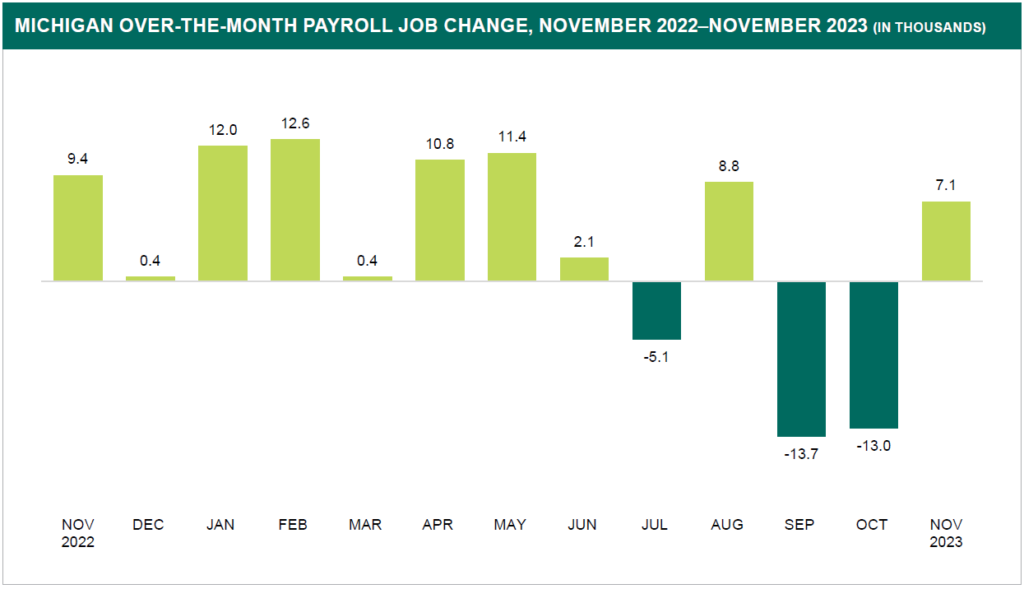
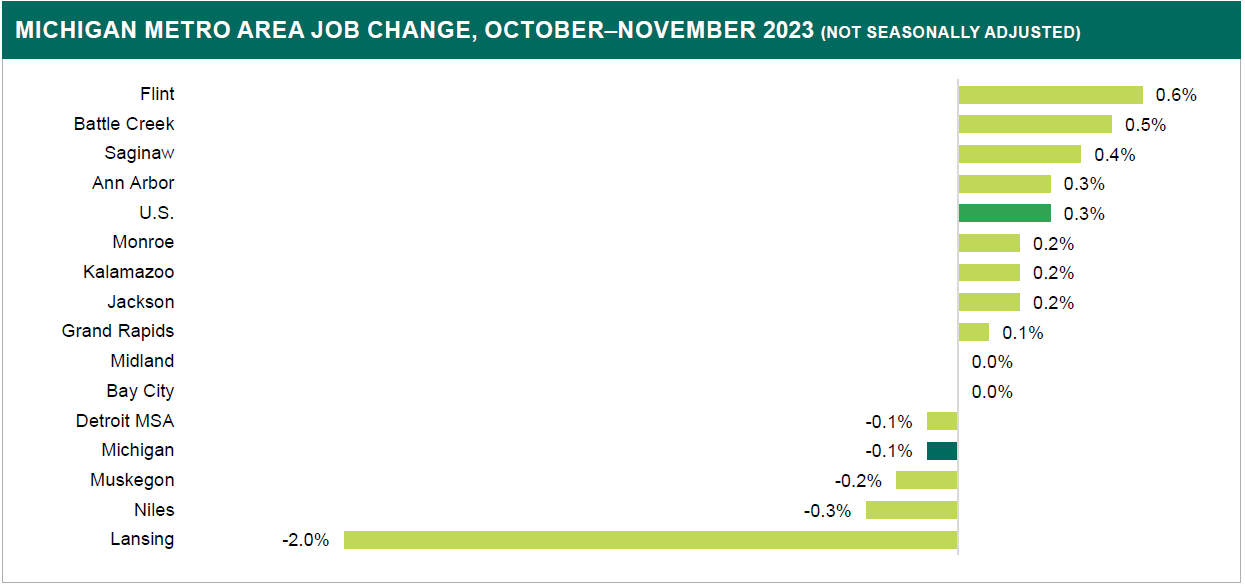
Source: Current Employment Statistics, Michigan Center for Data and Analytics, Michigan Department of Technology, Management & Budget

Source: Current Employment Statistics, Michigan Center for Data and Analytics, Michigan Department of Technology, Management & Budget
UNEMPLOYMENT TO JOB OPENINGS RATIO HIGHEST SINCE FIRST QUARTER 2021
The job openings rate (4.7 percent) in Michigan declined in the October release of the state Job Openings and Labor Turnover Survey (JOLTS). The separations rate (3.0 percent) and the labor turnover rate (6.4 percent) also decreased in October. Conversely, the hires rate (3.3 percent), layoffs/discharges rate (0.9 percent), and the quits rate (2.0 percent) all increased over the month.
Job Openings Continue Downward Trend
Michigan recorded approximately 220,000 job openings in October, a decline of 22,000 openings from the month prior (242,000). This was reflected in a 0.5 percentage point drop in the job openings rate, which fell from 5.2 percent to 4.7 percent. Michigan’s job openings rate was below the national rate at the time (5.3 percent) and was the eighth lowest of all other states.
The unemployed persons to job openings ratio saw a steep jump in October, moving from 0.74 to 0.94. This translated to a near one-to-one relationship between job openings and unemployed individuals according to the latest data. This was above the national ratio at the time (0.74) and was fourth highest in the nation.
Separations Decline
Similar to job openings, the separations rate declined slightly from September to October, falling 0.3 percentage points to 3.0 percent. Numerically, 12,000 more individuals separated from their jobs than in the previous month (134,000). Michigan’s separations rate was the 8th lowest of all other states and was below the national October separations rate (3.6 percent).
Driving the dip in separations was a decline in quits and layoffs/discharges. Both the quits rate and the layoffs/discharges rate dropped, clocking in at 2.0 percent and 0.9 percent, respectively. Michigan’s quits rate was below the national rate (2.3 percent) and layoffs/ discharges was also below the national rate at the time (1.0 percent).
Hires Tick Up Over the Month
The hires rate grew by a marginal 0.1 percentage point, moving from 3.2 percent in the prior month to 3.3 percent. This was reflected in a numeric increase of approximately 6,000 more hires in October (148,000) than in September (142,000). Michigan was below the national hires rate in October (3.8 percent).
Unemployment and Job Openings Nearly Equal
Openings Nearly Equal As mentioned previously, the unemployed persons to job openings ratio saw a notable jump in the October data release. This was the highest this ratio has been since March 2021, where it was recorded at 1.13. A ratio of one means that the number of unemployed individuals is equal to the amount of job openings, while a ratio greater than one means the former outnumbers the latter. Michigan’s ratio has crept up in recent months in this measure and may continue to do so if the current trend is any indication. This jump was driven primarily by the downward trend in job openings; as fewer jobs are made available, the divide between available workers and job opportunities has continued to shrink. This current trend may be interpreted as another indicator of a tightening labor market as alluded to in previous data releases.
KRYSTAL JONES
Economic Analyst
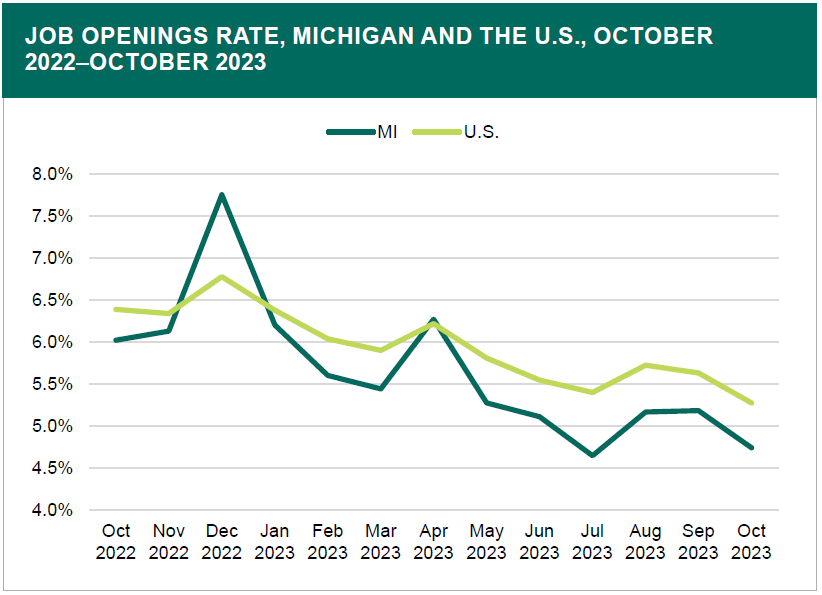
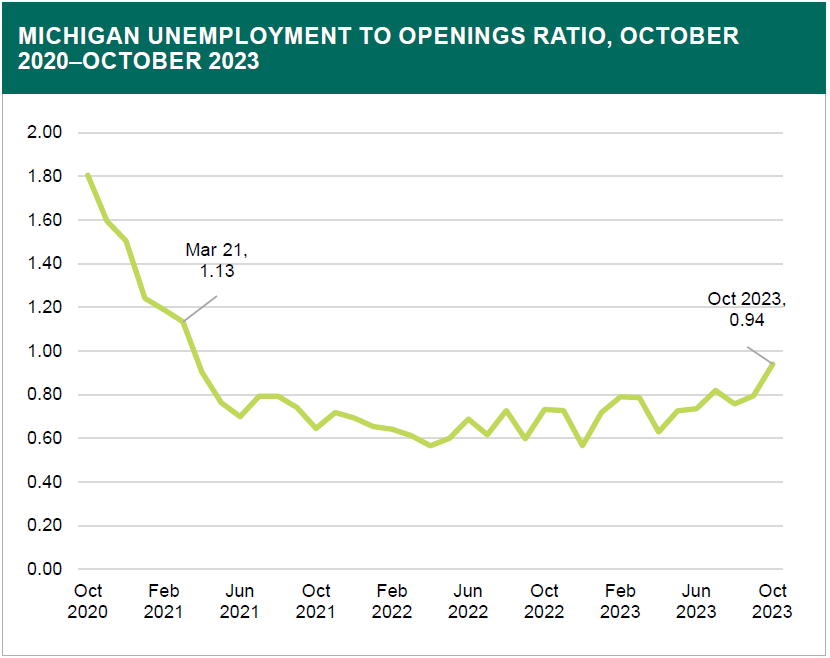
Source: Job Openings and Labor Turnover Survey, U.S. Bureau of Labor Statistics
Disclaimer
The Above Information was created and disseminated by the Department of Technology, Management, and Budget and the Bureau of Labor Market Information and Strategic Initiatives from the State of Michigan. Specialized Staffing does not hold any rights or ownership to this content. For more information, please contact your Michigan Bureau of Labor Representative.
